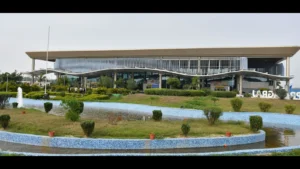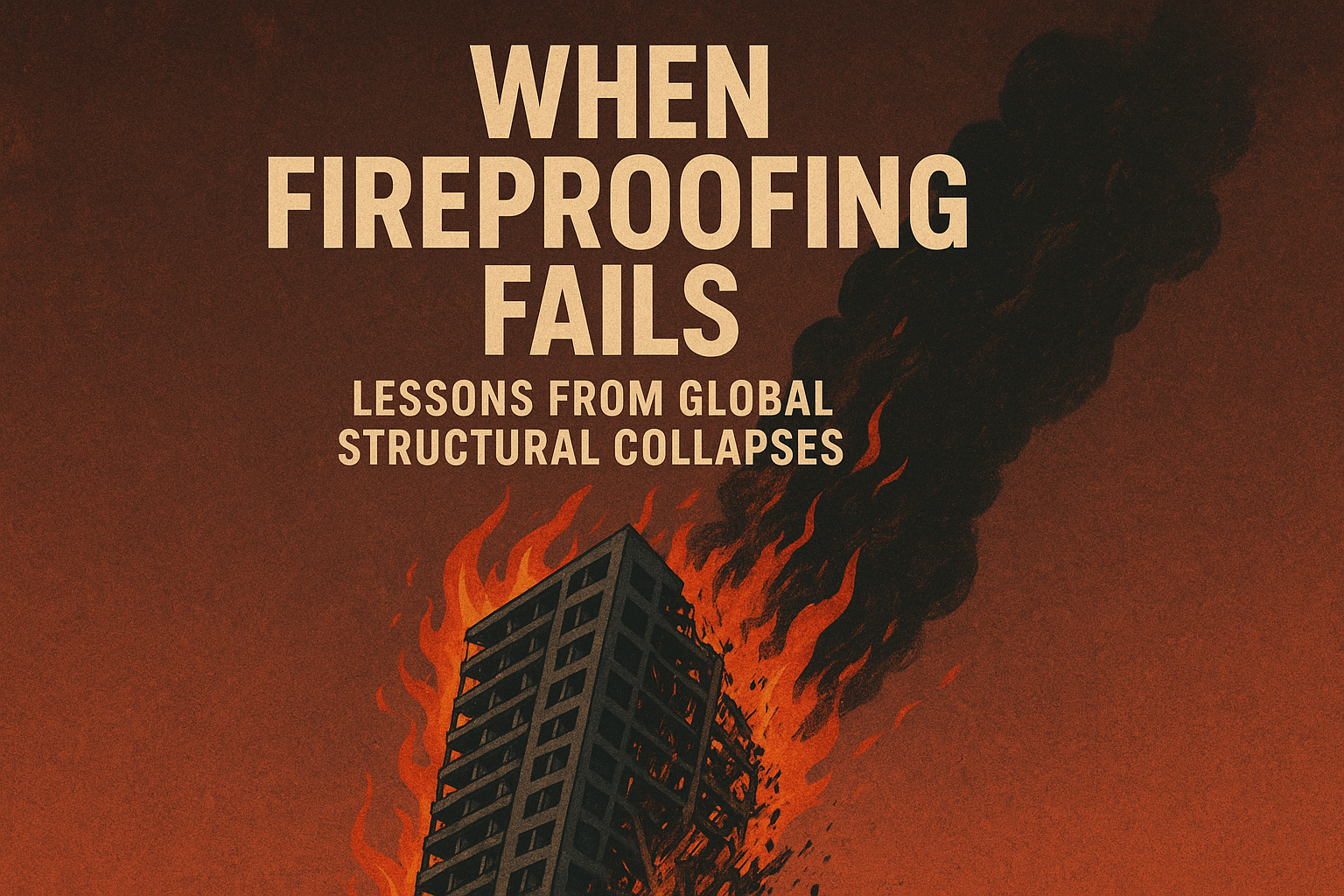Introduction
Fire is not only a test of materials, but a brutal truth-teller of engineering choices. Time and again, we’ve seen massive, heavy structures fail catastrophically — not because steel or concrete is inherently weak, but because the critical layer of passive fire protection was either absent or ineffective.
In some cases, no coating at all was applied, leaving bare steel to soften and twist in the furnace of uncontrolled flames. In others, cheap and outdated fireproofing materials like vermiculite were sprayed on, only to crack, flake, or get dislodged under stress — offering nothing more than a false sense of security.
Each failure carries the same message: fireproofing is not optional, and substandard fireproofing is no better than none at all.
Why Fireproofing Matters (Technical Basis)
Steel may be the backbone of modern infrastructure, but its Achilles’ heel is fire exposure.
- At 550 °C, structural steel loses ~50% of its yield strength.
- At 1,000 °C, it retains less than 10%, leading to catastrophic buckling.
- Reinforced concrete, though non-combustible, suffers from thermal shock and explosive spalling as trapped moisture turns into steam.
This is precisely why international and Indian fire codes mandate fire resistance:
- BS 476 Part 20 & 21 – Fire resistance of loadbearing beams, columns, floors, and roofs.
- BS 476 Part 22 – Fire resistance of non-loadbearing elements such as partitions, ducts, and fire barriers.
- ASTM E119 / ISO 834 – Standard fire test methods for building materials.
- IS 12458 & IS 12459 – Indian standards equivalent to BS 476.
- UL 263 / NFPA 251 – US standards for fire-resistance ratings.
All these converge on one fact: unprotected structural members fail within minutes, while properly coated ones can last 2–4 hours depending on dry film thickness (DFT) and Hp/A ratio.
Failures worldwide reveal three recurring mistakes:
- No fireproofing at all – bare steel or concrete left exposed.
- Substandard fireproofing – outdated vermiculite spray plasters, brittle and unreliable.
- Partial/incomplete coverage – one unprotected duct, column, or partition is enough to trigger systemic collapse.
Case Studies: Global Evidence of Fireproofing Failures
Stephen Court Fire, Kolkata (2010)
A blaze sparked by an electrical short circuit tore through illegally added upper floors. With no fire-resistant partitions, barriers, or coatings, flames engulfed the building. Floors collapsed, stairwells failed, and 43 occupants died. Investigations confirmed that the lack of compartmentalization and passive protection was decisive in the collapse.
(Wikipedia – Stephen Court fire)
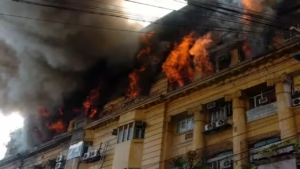
2003 Hengyang Warehouse Fire, China
A warehouse storing flammable goods erupted into an inferno exceeding 1,000 °C. Columns with low-quality rebar and inadequate vermiculite coating lost strength quickly, leading to full structural collapse. 20 firefighters were killed when the roof came down on them.
(Wikipedia – Hengyang fire)
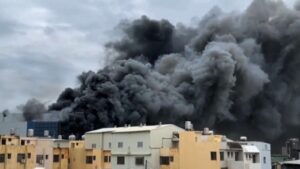
World Trade Center Towers, New York (2001)
Both towers were designed with fireproofing, originally asbestos but later replaced with vermiculite spray plaster. Critical flaws:
- Only 18 floors of WTC 1 and 13 of WTC 2 had upgraded coatings.
- Vermiculite’s brittleness meant much of it dislodged during aircraft impact.
- Without insulation, trusses softened within minutes, accelerating collapse.
The NIST investigation emphasized that fireproofing quality and adhesion were decisive factors in structural failure.
(NIST Report – WTC Collapse)
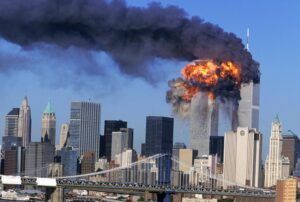
Formosa Plastics Propylene Explosion, USA (2005)
In this industrial fire, only three of four support columns were fireproofed. The unprotected column failed first, pulling down the roof. Investigators concluded that selective protection undermines the whole system.
(CSB Report – Formosa Plastics Explosion)
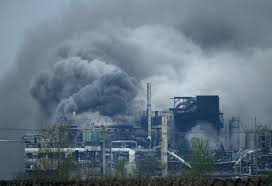
Hyderabad Unsafe Buildings (2024)
After major blazes, engineers declared several commercial/residential blocks unsafe. Findings: concrete frames and ducts had no fireproofing at all. Yet occupants returned after cosmetic repairs. Experts warned: the next fire could still cause collapse in under 20 minutes.
(Times of India)
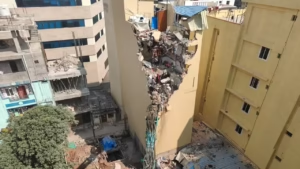
Key Lessons
| Incident | Fireproofing Status | Outcome | Lesson |
| Stephen Court, Kolkata (2010) | None | Floors collapsed; 43 deaths | No barriers/compartmentalization = rapid fire spread and collapse |
| Hengyang, China (2003) | Poor-quality vermiculite coating | Collapse; 20 firefighters killed | Substandard fireproofing failed under high heat |
| WTC Towers, USA (2001) | Partial vermiculite fireproofing | Collapse of both towers | Brittle vermiculite dislodged, leaving steel exposed |
| Formosa Plastics, USA (2005) | Partial protection (3/4 columns coated) | Structural collapse | One unprotected column triggered systemic failure |
| Hyderabad Blocks (2024) | No fireproofing, cosmetic repairs only | Declared unsafe; risk of collapse | Post-fire rehabilitation without coating leaves buildings vulnerable |
Recommendations: How These Collapses Could Have Been Prevented
- Full Coverage, No Exceptions
BS 476 requires all loadbearing and non-loadbearing elements to be protected. Even one unprotected column or duct can bring down an entire structure. - Ban Substandard Materials
Outdated vermiculite systems must be replaced with tested intumescent epoxy or dense cementitious coatings. They provide proven insulation and adhesion. - Certified Testing
Fireproofing must be tested to BS 476, ASTM E119, ISO 834, or IS 12458/59 — and verified during application. - Regular Inspection
Annual maintenance is critical. Renovations or leaks can expose bare steel; re-application must be immediate. - Treat Fireproofing as Structural
Fireproofing is not decorative paint — it is a load-bearing safeguard. Without it, design fire ratings collapse from hours to mere minutes.
Conclusion
Every case — from Stephen Court in India to Hengyang in China, WTC in the US, Formosa in industry, and modern Hyderabad buildings — proves the same rule:
- No coating = guaranteed collapse.
- Cheap vermiculite = false safety.
- Partial coverage = systemic failure.
Fire doesn’t forgive shortcuts. Passive fire protection must be comprehensive, certified, and maintained — or the building itself becomes the fuel.
